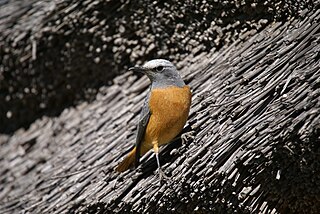
The rock thrushes, Monticola, are a genus of chats, medium-sized mostly insectivorous or omnivorous songbirds. All are Old World birds, and most are associated with mountainous regions.

The common rock thrush, also known as rufous-tailed rock thrush or simply rock thrush, is a chat belonging to the family Muscicapidae. It was formerly placed in the family Turdidae. The scientific name is from Latin. Monticola is from mons, montis "mountain", and colere, "to dwell", and saxatilis means "rock-frequenting", from saxum, "stone".

The blue rock thrush is a species of chat. This thrush-like Old World flycatcher was formerly placed in the family Turdidae. It breeds in southern Europe, northwest Africa, and from Central Asia to northern China and Malaysia. The blue rock thrush is the official national bird of Malta and was shown on the Lm 1 coins that were part of the country's former currency.

The African stonechat or common stonechat is a species of the Old World flycatcher family (Muscicapidae), inhabiting sub-Saharan Africa and adjacent regions. Like the other chats, it was long assigned to the thrush family (Turdidae), to which the chats are convergent. Its scientific name refer to its appearance and habitat and means "collared rock-dweller": Saxicola from Latin saxum ("rock") + incola, torquatus, Latin for "collared".

The Cape rock thrush is a member of the bird family Muscicapidae. This rock thrush breeds in eastern and southern South Africa, Lesotho and Eswatini. It is a common endemic resident, non-migratory apart from seasonal altitudinal movements in some areas.
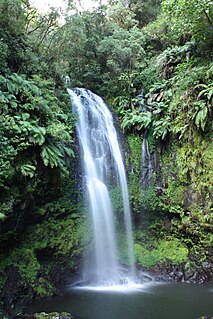
Montagne d'Ambre National Park is a national park in the Diana Region of northern Madagascar. The park is known for its endemic flora and fauna, water falls and crater lakes. It is 1,000 kilometres (620 mi) north of the capital, Antananarivo and is one of the most biologically diverse places in all of Madagascar with seventy-five species of birds, twenty-five species of mammals, and fifty-nine species of reptiles known to inhabit the park.

The streak-breasted bulbul, is a songbird species in the bulbul family, Pycnonotidae.
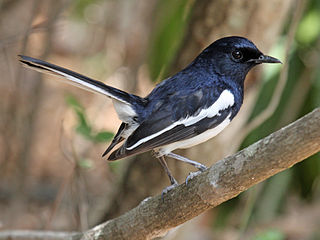
The Madagascar magpie-robin is a species of chat in the Old World flycatcher family, Muscicapidae.

The Sunda forktail is a species of bird in the family Muscicapidae. It is endemic to Indonesia, where it is restricted to the islands of Java and Sumatra. Its natural habitat is boulder strewn streams in tropical moist montane forest from 600–2000 m. More rarely the species occurs closer to sea level. The species is common in Sumatra, but is rarer in Java, where the white-crowned forktail is more common.
The mountain shrike or grey-capped shrike, is a species of bird in the family Laniidae. It is endemic to the Philippines.

The short-toed rock thrush is a species of bird in the family Muscicapidae. It is found in Angola, Botswana, Namibia, and South Africa. Its natural habitat is subtropical or tropical dry shrubland.

The Amber Mountain rock thrush is a songbird in the family Muscicapidae, formerly placed in the Turdidae together with the other chats. It is now usually considered a subspecies of the forest rock thrush.
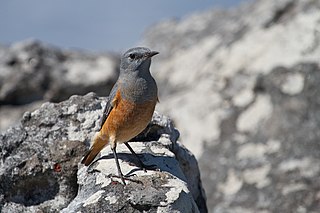
The sentinel rock thrush is a species of bird in the family Muscicapidae. It is found in Lesotho, South Africa, and Swaziland. Its natural habitat is subtropical or tropical high-altitude grassland.
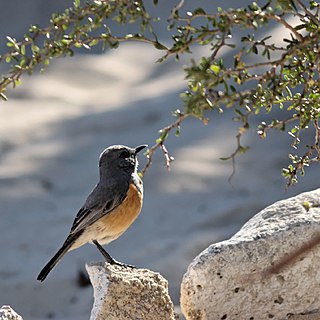
The littoral rock thrush, is a species of bird in the family Muscicapidae. It is endemic to Madagascar.

The little rock thrush is a passerine bird in the family Muscicapidae. It is found in Eritrea, Ethiopia, Kenya, Oman, Saudi Arabia, Somalia, South Sudan, Tanzania, Uganda, and Yemen. It is found in rocky areas with some trees, and sometimes near settlements. At 15 to 16 centimetres this is the smallest of the Muscicapidae. The male has the head, throat and upper mantle blue-grey, the underparts orange-red, except for the center blackish center tail and tips which form an inverted T shape. The female is duller and paler. It is readily mistaken for a redstart because of its habit of trembling its tail.

The forest rock thrush is a songbird in the family Muscicapidae, formerly placed in the Turdidae together with the other chats. It now includes Benson's rock thrush and Amber Mountain rock thrush as subspecies.

The Taiwan whistling thrush, also known as the Formosan whistling thrush, is a species of bird in the family Muscicapidae. It is endemic to Taiwan.

The common newtonia is a species of bird in the family Vangidae. It is endemic to Madagascar.
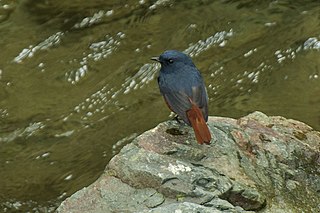
The Luzon water redstart, also known as the Luzon redstart, is a species of bird in the family Muscicapidae. It is endemic to the Philippines found primarily on Luzon with no records in Mindoro since 1965. Its natural habitats are tropical moist lowland forest, subtropical or tropical moist montane forest, and rivers. It is threatened by habitat loss.
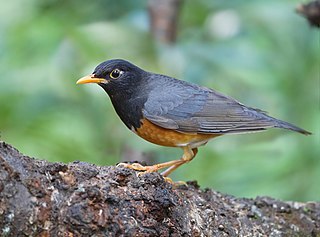
The black-breasted thrush is a species of bird in the family Turdidae. It is found from north-eastern India to northern Vietnam. Although both male and female birds have the same colour on their lower parts, the upper section of males is mostly black in colour, while females are mostly grey-brown. Thus, the bird's common name refers to the colour of the male bird's breast. They tend to live in forests located at high altitude.




















